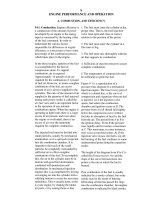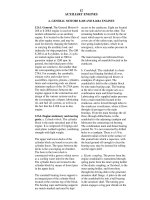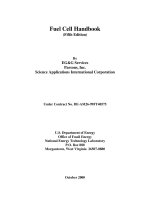Tài liệu DeMaMech Exchange Project docx
Bạn đang xem bản rút gọn của tài liệu. Xem và tải ngay bản đầy đủ của tài liệu tại đây (493.15 KB, 12 trang )
DeMaMech Exchange Project
Report
Sander Pastoor, TU Delft, The Netherlands
1
Personal Data
Student
Sander T. Pastoor
Home University
Delft University of Technology
Faculty of Mechanical Engineering and Marine Technology
Life Cycle Engineering
Mekelweg 2, 2628 CD Delft, The Netherlands
Supervisor: Professor Dr. T. Tomiyama
Host University
Osaka University
Graduate School of Engineering,
Dept. of Computer-Controlled Mechanical Systems,
Yamadaoka 2-1, Suita, Osaka, 560-0871 JAPAN
Supervisor: Professor Dr. Y. Takeuchi,
2
DeMaMech Exchange Project is a program where European students go to Japan and
Japanese students go to Europe for study purpose. All students are studying in the field of
Design and Manufacturer in Mechatronics. Students can apply for a period of five or ten
months to do a small research or master thesis.
I had the opportunity to go to Osaka, Japan, for ten month from September 2004. I found my
Master thesis project at Takeuchi’s Labaratory Japanese Labaratory, where they offered me
a challenging project. In this Labaratory they study and develop CAM System for Multi-Axis
Control Machining. My project was about improving the accuracy of a parallel kinematics
machine tool.
In Japan I experienced immediately the differences between Japanese (Asian) and Dutch
(European) culture. The language was difficult, and studying at a Japanese University is
totally different. Group mentality is strong in Japan where Europeans are more used to
induvidual approach. I also expected a more “high-tech” Japan, but streets don’t look like that
and I experienced a lot of paperwork at public offices. Japanese are hard working, good
motivated people, and little shy, but many with a warm heart. So it was very nice to live there.
Research was done during the entire ten month, and besides that I attend succesfully the first
level of Japanese at the university. Many Japanese people don’t speak English very well, so
for more social contact I wanted to learn more Japanese. Now, I am able to have a
conversation. Researching was sometimes difficult due to language barrier but sometimes
very nice with a lot of freedom for me as “ foreigner”. They understood that I was used to
work in a different way. I had to improve the machine accuracy of a Parallel kinematic
machine tool. Therefore, the accuracy was investigated with machining experiments. Besides
that a mathematic model has been build, so I was able to analyse the influence of several
possible error sources like assembly and gravity related errors. Finally, a solution was
proposed to reduce the error for machining. However, due to machine problems this couldn’t
be finished completely. My temporary results I presentated at Toyoda Machine Works and I
wrote a paper about my research, which I may present at IMCT conference at Kuala Kumpur
December 2005.
Life in Japan was tough in the beginning, I had to get used to the Japanese culture. Later I
enjoyed it more and more and made more friends, Japanese and with other people from all
over the world. Changes given me by especially Prof. Dr. T. Tomiyama, gave me
unforgetable and worthy experiences and moments for the rest of my life. I can do nothing
else than thank the organising people and recommand everybody who gets the opportunity
to join this project to go!
Chapter
2
Executive Summary
3
15 September 2004 Amsterdam – Osaka (10.5 hours)
The flight was a direct flight between Amsterdam and Osaka
with KLM. The ticket offered was a special student ticket
with an open return date within one year.
29 August 2005 Osaka – Amsterdam (12 hours)
Some travel advices:
On most flight there is limitation in weight you can bring with you. Sending things by sea mail
gives you the possibility to send many kilos cheap from Japan to Europe. (20 kilo – 10.000
yen = 70 euro). It will take about 4 or 5 weeks but who cares about delay of your winter jacket
or some study books?
Traveling in Japan is easy by train. Also for long distance the fast Shinkansen is an easy but
expensive solution. Why don’t you take a cheap bustrip! At Osaka university campus Travel
Agency or another one you can find cheap bus trip from Osaka to many places in Japan. For
example to Hiroshima about 8.000 yen (60 euro) to Tokyo it costs about 9.000 yen (65 euro)
return, while shinkansen train costs you 26.000 yen (200 euro).
For local trains you can buy a prepaid card, it not cheaper but it more convenient instead of
buying all the time a ticket from the ticket machines.
Some nice places to visit are:
Tokyo
, beautiful buildings, crowded streets, eating and shopping everywhere and other
DeMaMech students / friends.
Nara
, located close to Osaka where you can find “Nara Park”. With many old temples and
shrines, very nice to walk around and see the old beauty of Japan.
Kyoto
, a big city that is very famous for it’s traditional Japanese culture. Many temples in a
city like all others. You can enjoy “ temples watching”, some nice festivals, and the old town
“Gion”.
Hiroshima
, city of the atomic bomb attack. You can see the momuments and a imprssive
museum. Close to Hiroshima you can find himejima a very famous and beautiful temple on
an island.
Futhermore, you can enjoy the nice beaches in Japan, musea if you like, the huge theme
Parks (like Universal Studios Japan), or hiking in the mountains. So, for travelling there are
many nice possibilities
Chapter
3
Travel Schedule
4
Introduction / Summary
Before I left from Holland to Japan I found a nice challenging project at Osaka
University in Prof. Dr. Takeuchi his Laberatory. It was important to get clear what they
expected from my side, and what the project was exactly about. Therefore, be prepared
and know what you have to do. Japanese thesis work is different than the European so
understanding of each other’s method is required for a good start in Japan.
My laboratory is researching “Development of
CAM System for Multi-Axis Control Machining”.
Sevaral multi-axis machines are available for
research, in my case a Parallel kinematic machine
tool, shown in Figure 4.1
Parallel kinematic machine tools are a new
promising concept in the search for new machine
tools. Interesting application is in material removal that
compels high speed and accuracy requirements for
nowadays production. Those machine tools deal with
the typical accuracy problems, which come with
parallel machine structures. Especially, accuracy
improvement of the non-uniform position errors is
emergently required as the first step of machining
improvement.
In this research, the focus was on the investigation of the geometrical errors,
gravity and the calibration related machine errors. A kinematic model is used to
investigate and simulate the influence of several error sources on machining.
Using simple milling experiments, the errors after machining were investigated for
several milling cases. Using the gathered knowledge of experiments and simulations, an
error prediction model has been realized to calculate the error compensation vector,
which can be used in CAM environment. In that application, the tool path is recalculated,
using an error prediction model. Every single machining coordinate is changed using the
error compensation vector. So, improving of machining accuracy with error
compensation, by use of cutting conditions and position knowledge, has a possibility to
improve the machine accuracy without changing the machine structure.
Title
“Improvement of machining accuracy for parallel kinematic machine
tools using error prediction and compensation for CAM application”.
Chapter
4
Research
Figure 4.1: HexaM, from Toyoda
M
achine Works, Japan









